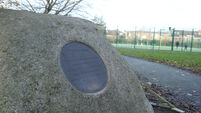Cork city’s drinking water is ‘at risk’

The problem, which affects 127,548 people, relates to “treatment and management issues”.
It is one of 87 “at-risk” sources in the country, according to the EPA’s Drinking Water Report 2016, which is published today.
An upgrade of the treatment plant, which is not due to be completed until March 2020, has been proposed.
In the mean time, interim measures of improving “chemical dosing arrangements and flood protection”, have been recommended.
There are nine other water supplies in Cork which have been included on the “at risk” list.
Some of these include Schull, Drimoleague, and Millstreet.
The problem with Millstreet, which serves 3,609 people, is an “inadequate treatment for cryptosporidium”.
Cryptosporidium is a parasite that is found in human or animal waste. If consumed, it can cause persistent diarrhoea.
A total of 161,000 people around Ireland are at risk of consuming this microscopic parasite in drinking water, the EPA has warned.
This equates to 25 drinking water supplies to homes, schools, hospitals and businesses in the country not having adequate treatment to kill off the diarrhoea- inducing bug.
Approximately 26,905 people living in and around Letterkenny, Co Donegal, are affected, as are another 62,066 people living under threat from the parasite in the Killarney and Tralee areas of Co Kerry.
Darragh Page, senior drinking water inspector in the EPA’s Office of Environmental Enforcement, said: “Our biggest concern is about these 25 supplies that have inadequate treatment for cryptosporidium.”
In an overall sense, while 99.9% of samples comply with the microbiological standards and 99.5% of samples comply with the chemical standards, the EPA is still concerned about drinking water supplies that serve almost 1m people.
“The EPA has identified supplies serving over 700,000 consumers where improvements to water treatment infrastructure are necessary to meet public health standards,” said Gerard O’Leary, director of the EPA’s Office of Environmental Enforcement.
Of the 87 “at-risk” locations, 58 of these have elevated levels of trihalomethanes (THMs).
THMs, which are chemicals, “are classified as ‘possibly carcinogenic’ to humans”, according to the HSE.
Mr Page said a national approach must be taken to stop chemicals entering water sources.
“The number of supplies reporting THM failures remains high, and a consistent national approach must be adopted to ensure that pesticides are prevented from entering our drinking water sources,” he said.
Pesticides are applied to farmlands and gardens and can seep into ground water or surface water systems that feed drinking water supplies.
Last year, 84,348 people, in 16 counties were affected by 41 “boil water” notices and 15 directions were given to Irish Water by the EPA.
The watchdog has identified some priorities for Irish Water to address immediately.
Some of these include the elimination of long-term boil water notices and preventing pesticides from entering our drinking water sources.














